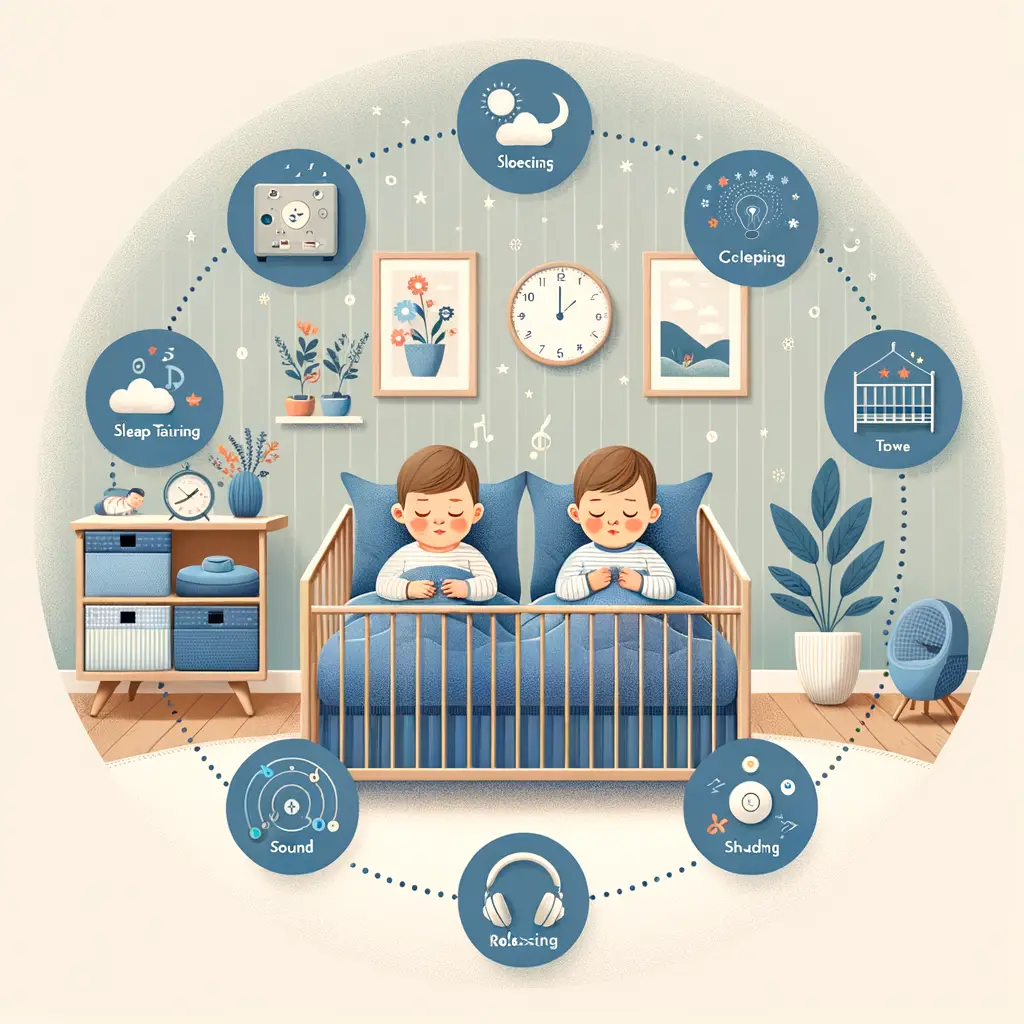Introduction to Twins Sleeping Habits
Having twins is a unique and rewarding experience. However, it also comes with its own set of challenges, one of which is understanding and managing the sleep patterns of twins. This article aims to help parents gain a better understanding of their twins’ sleep habits and the factors that can affect their sleep training.
Understanding the Unique Sleep Patterns of Twins
Twins often have similar sleep patterns, especially if they share the same room. This is because they are used to the same environment and routine. However, each twin is an individual and may have slightly different sleep needs. For example, one twin may need more sleep than the other, or they may nap at different times. It’s important to observe your twins and understand their unique sleep patterns to ensure they are getting the rest they need.
Factors Affecting Twins Sleep Training
Several factors can affect the sleep training of twins. These include their age, their individual sleep needs, and their environment. For instance, younger twins may need more frequent naps, while older twins may be ready to sleep through the night. Additionally, twins who share a room may influence each other’s sleep patterns. If one twin wakes up, the other may also wake up. Therefore, it’s crucial to consider these factors when sleep training your twins.
In the following sections, we will delve deeper into the benefits and drawbacks of having twins share a room, and how this can impact their sleep habits. By understanding these factors, parents can make informed decisions about their twins’ sleep routines and create an environment that promotes healthy sleep habits.
Shared Room for Twins: The Benefits
When it comes to raising twins, one of the most common questions parents ask is whether or not their twins should share a room. While there are certainly pros and cons to consider, there are numerous benefits to having twins share a room, especially during their early years.
Same Room Sleeping Benefits for Twins
There are several key benefits to having twins share a room, including:
Enhanced bonding and communication: Twins who share a room often develop a strong bond and enhanced communication skills. They learn to share, cooperate, and resolve conflicts, which can be beneficial for their social development. According to a Wikipedia article, twins often develop a private language (known as idioglossia) that can enhance their bond.
Improved sleep routines for twins: Twins sharing a room can help establish consistent sleep routines. When one twin wakes up, it’s often easier to get the other one up too, and vice versa. This can lead to more synchronized sleep schedules, making it easier for parents to plan their day.
Convenience for parents: Having twins in the same room can also be more convenient for parents. It’s easier to monitor and attend to both babies when they’re in the same room. Plus, it can save space in the home.
In conclusion, while every family and every set of twins is unique, many parents find that the benefits of a shared room for twins outweigh the potential drawbacks. It’s a decision that should be based on your family’s specific needs and circumstances, but it’s certainly an option worth considering.
Case Study: Successful Shared Room Arrangement for Twins
Let’s dive into real-life examples of how parents have successfully managed a shared room arrangement for their twins. We will look at practical examples of managing twins’ sleep schedules and key takeaways from these experiences.
Practical examples of managing twins sleep schedule
One of the most effective ways parents have found to manage their twins’ sleep schedule is by synchronizing their sleep times. For instance, the Johnson family from Texas, parents of 5-year-old twins, shared their experience. They started by feeding their twins at the same time, followed by a bedtime routine that includes a bath, story, and lullaby. This routine helped their twins understand that it’s time to sleep and made them accustomed to sleeping at the same time. Over time, the twins developed a consistent sleep pattern, which made it easier for the parents to manage their time and rest as well.
Key takeaways from parents who have successfully implemented a shared room for twins
Many parents have found success with a shared room arrangement for their twins. Here are some key takeaways from their experiences:
Consistency is key: Maintaining a consistent sleep schedule and routine helps twins adjust to a shared room arrangement.
Individual space: Even in a shared room, it’s important to give each twin their own space. This can be done by using two separate cribs or beds and personalizing each area with their favorite toys or colors.
Patience and flexibility: Adjusting to a shared room arrangement can take time. It’s important to be patient and flexible, adjusting the arrangement as needed to suit the twins’ needs and comfort.
In conclusion, a shared room arrangement for twins can be a successful and beneficial setup with the right approach and strategies. By maintaining a consistent sleep schedule, providing individual space, and being patient and flexible, parents can create a comfortable and nurturing environment for their twins. 
Shared Room for Twins: The Drawbacks
While sharing a room can create a strong bond between twins, it can also present unique challenges, particularly when it comes to sleep. In this section, we’ll explore some of the potential drawbacks of twins sharing a room.
Twin Children Sleep Issues in Shared Rooms
Disruptions in sleep due to one twin’s restlessness: If one twin is restless, it can disrupt the other’s sleep. This can lead to both twins waking up frequently throughout the night, resulting in less restful sleep overall.
Difficulties in establishing individual sleep routines: Twins who share a room may find it difficult to establish their own sleep routines. This can be particularly challenging if one twin is a night owl and the other is an early bird.
Real-life examples of challenges faced in twins room sharing: Many parents of twins have shared their experiences of the challenges they faced when their twins shared a room. For example, one parent reported that their twins would often wake each other up during the night, leading to sleep deprivation for the entire family.
Key insights from parents who faced difficulties in managing twins sleep schedule: Parents who have struggled with managing their twins’ sleep schedules often recommend establishing a strict bedtime routine and investing in sound machines to help drown out any noise one twin might make.
Benefits of co-sleeping twins: Despite the challenges, there are also benefits to twins sharing a room. For example, twins often provide comfort to each other, which can help them fall asleep more easily.
Potential risks and how to mitigate them: There are potential risks associated with twins sharing a room, such as the spread of illness. However, these risks can be mitigated by ensuring the room is kept clean and that the twins are taught good hygiene habits.
Advantages of separate rooms for individual sleep training: Having separate rooms can make it easier to establish individual sleep routines and can reduce the likelihood of one twin waking the other up.
Possible drawbacks and how to overcome them: While separate rooms can have their advantages, they also have potential drawbacks, such as increased costs and the potential for the twins to feel lonely. These drawbacks can be overcome by ensuring the twins spend plenty of time together during the day and by using baby monitors to keep an eye on them at night.
Factors to consider when deciding on twins sleep arrangement: When deciding on a sleep arrangement for twins, parents should consider factors such as the twins’ personalities, their sleep habits, and the available space in the home.
Final thoughts on shared room for twins vs separate rooms: Ultimately, the decision between a shared room and separate rooms for twins is a personal one that depends on the unique needs and circumstances of each family.














